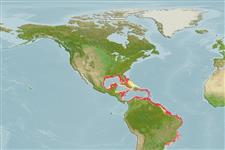Common names from other countries
Environment: milieu / climate zone / depth range / distribution range
Ecología
marino demersal; rango de profundidad 20 - 150 m (Ref. 5217). Subtropical; 30°N - 26°S, 98°W - 34°W
Western Atlantic: northwestern Gulf of Mexico to Brazil.
Tamaño / Peso / Age
Maturity: Lm ? range ? - ? cm
Max length : 32.0 cm TL macho / no sexado; (Ref. 5217); common length : 25.0 cm TL macho / no sexado; (Ref. 3275); peso máximo publicado: 371.30 g (Ref. 128822)
Espinas dorsales (total) : 0; Radios blandos dorsales (total) : 82 - 90; Espinas anales: 0; Radios blandos anales: 63 - 69. Body is oval, moderately elongate. Dorsal fin originates distinctly anterior to a vertical at front of the eyes. Eyes on left side, not large, their diameter is 5 - 5.9 times the head length. The interorbital space is narrow, less than half the eye diameter. Lateral line on eyed side is not steeply arched above pectoral fin. The mouth is large extending slightly beyond the posterior margin of the eyes. Caudal fin is rounded. Color is brown with a large blotch beneath pectoral fin. The dorsal and anal fins have a row of dark spots containing pale areas,. Two spots on the dorsal and a few on the anal are large. The caudal fin has three large dark spots at the posterior border, none on center of the fin. Number of ovaries: 2. Ovaries are symmetrical, lie parallel with each other, depressed cross-sectionally and extra-visceral in location (Ref. 101557).
Occurs in bays, lagoons and shallow coastal waters. Found on soft bottoms (Ref. 5217). Marketed fresh (Ref. 5217).
Life cycle and mating behavior
Maturities | Reproducción | Spawnings | Egg(s) | Fecundities | Larva
Distinct pairing (Ref. 205). Number of ovaries: 2. Ovaries are symmetrical, lie parallel with each other, depressed cross-sectionally and extra-visceral in location (Ref. 101557).
Robins, C.R. and G.C. Ray, 1986. A field guide to Atlantic coast fishes of North America. Houghton Mifflin Company, Boston, U.S.A. 354 p. (Ref. 7251)
IUCN Red List Status (Ref. 130435)
CITES (Ref. 128078)
Not Evaluated
Threat to humans
Harmless
Human uses
Pesquerías: escaso valor comercial
Herramientas
Special reports
Download XML
Fuentes de Internet
Estimates based on models
Preferred temperature (Ref.
115969): 19.6 - 27.4, mean 24.8 (based on 192 cells).
Phylogenetic diversity index (Ref.
82804): PD
50 = 0.5625 [Uniqueness, from 0.5 = low to 2.0 = high].
Bayesian length-weight: a=0.00891 (0.00405 - 0.01963), b=3.11 (2.93 - 3.29), in cm Total Length, based on LWR estimates for this (Sub)family-body shape (Ref.
93245).
Nivel trófico (Ref.
69278): 3.6 ±0.2 se; based on size and trophs of closest relatives
Resiliencia (Ref.
120179): Alto, población duplicada en un tiempo mínimo inferior a 15 meses (K=0.78).
Fishing Vulnerability (Ref.
59153): Low vulnerability (20 of 100).
